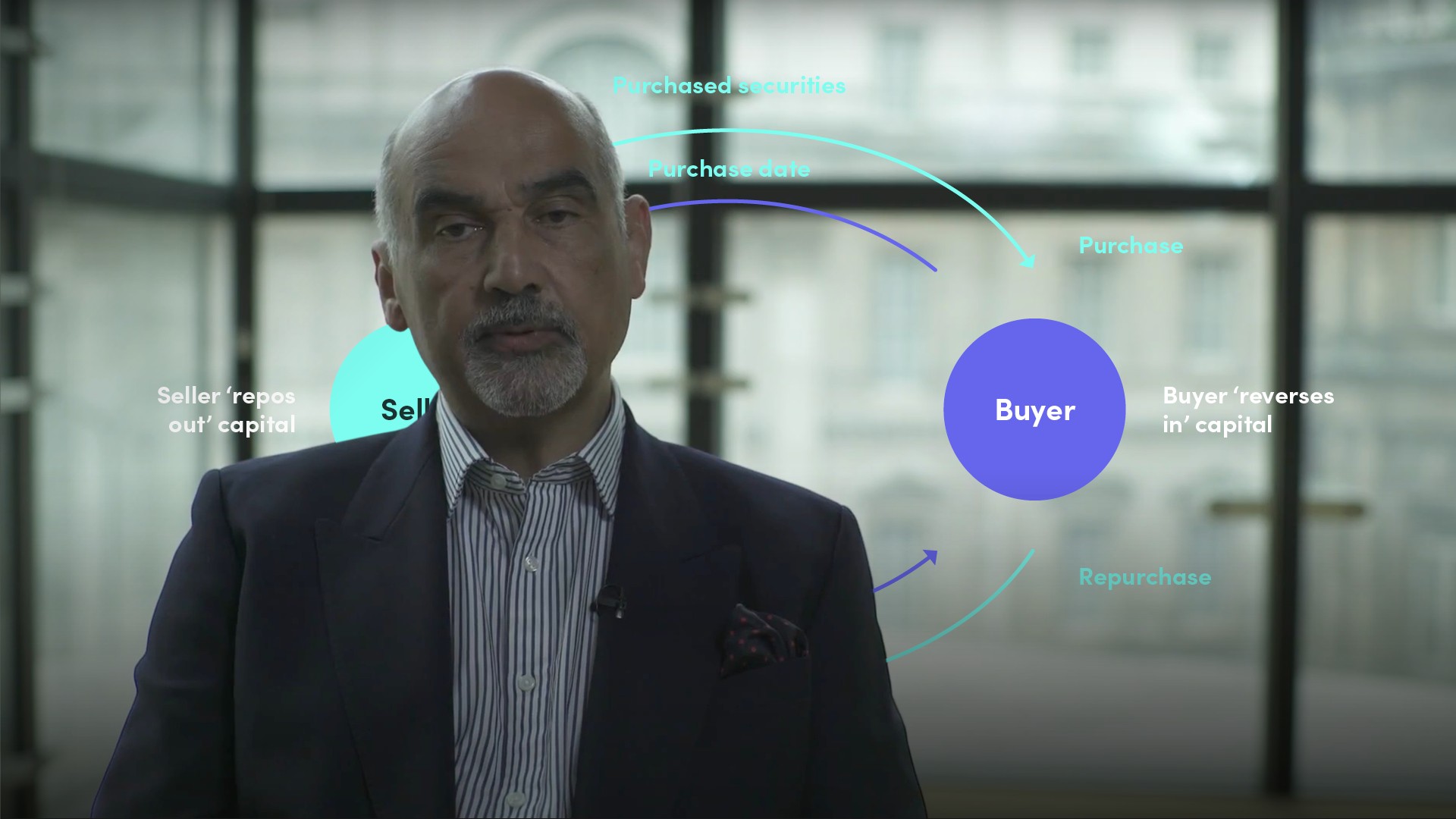
Repo Pricing Illustration

Richard Comotto
30 years: Money markets
Richard walks through a realistic example of a repo to understand the mechanics of the transaction.
Richard walks through a realistic example of a repo to understand the mechanics of the transaction.

Repo Pricing Illustration
8 mins 18 secs
Key learning objectives:
Identify two fundamental use cases of repos
Learn to calculate the market value
Learn to calculate the repo value
Overview:
This case analysis details the pricing, transaction process and fundamental use cases of a repo. This includes, financing a long position and covering a short position.
| Term | 1 Week |
| Collateral | 4.75% DBR 04/07/34 (annual A/A) |
| Nominal Value | 25,000,000 |
| Clean Price | 163,483 |
| Accrued Interest | 204 Days |
| Repo Rate | -0.308% (A/360) |
What are the different ways of calculating the market value?
Method 1:
Apply the clean price and coupon separately to the nominal value and then add the amounts. The value of the bond at the clean price of 163.483, is 40,870,750, and the value of 204 days of accrued interest at a coupon of 4.75%, is 663,698.63. Added together, this gives a market value for the bond of 41,534,448.63.
Method 2:
We start by calculating the dirty price of the bond by adding the coupon rate prorated to 204 days to the clean price. The dirty price is 166.137795. This is applied to the nominal value, gets us the same market value of 41,534,448.63.
How do we calculate the repo?
First we must establish the purchase price or initial cash amount of the repo. To do this, having calculated the market value of the collateral, we must decide whether there is to be a haircut or initial margin. For simplicity, let’s say there will not be a haircut or initial margin in this example. This decision fixes the purchase price at the market value of the collateral.
Next, let’s fix the repurchase price or end cash amount. Apply the repo rate to the purchase price for seven days to calculate the repo interest using a simple interest calculation. The repo interest comes to negative 2,487.45. Adding this to the purchase price gives a repurchase price of 41,531,961.18. In effect, we have just done a simple deposit calculation. This reflects the economics of a repo, which is after all a secured loan.
How can a repo be used to finance a long position in a security?
Context 1:
In the first example, we’ll use a one-week repo to finance a long position in a five-year French government bond. At the start, I buy the bond from the cash market to open the long position. To finance the purchase, I arrange a one-week repo using the bond as collateral. At the end of the week, the repo will mature and I will get the bond back, which I sell back to the cash market to close the long position. The cash from the long sale is used to pay back the repo.
Example 1:
Assume I arrange to buy the bond on Tuesday 2 June in the cash market from Citibank for delivery T+2, that is, on Thursday 4 June for 10,550,000. At the end of Tuesday, I’ll tell my repo desk that I need one-week repo funding for this bond. On Wednesday, the repo desk agreed to a one-week repo with JP Morgan for 0.10%. Assume they agree to use the same price for the bond that I agreed with Citi.
On Thursday 4 June, Citi delivered the bond to me and I paid them 10,550,000. I deliver the bond to JP Morgan and they pay me 10,550,000. I now have a long position in place. I want to run that position for one week until Thursday 11 June. To close out that position on that date, I will have had to sell the bond on Tuesday 9 June, given that delivery in the cash market is T+2. Assume I sell to SocGen for 10,100,000. On Thursday 11 June, the repo will mature and I will have to pay a repurchase price of 10,550,205 to JP Morgan in order to get my bond back to deliver to SocGen, who will pay me 10,100,000. Unfortunately, I have made a loss in this example.
How can a reverse repo be used to cover a short position?
Context 2:
In the second example, we’ll use a one-week reverse repo to finance a short position in the same five-year French government bond. At the start, I sell the bond, which I do not possess, to the cash market to open the short position. To cover the short position, in other words to be able to deliver my short sale, I arrange to borrow the bond for a week through a reverse repo. I will use the proceeds of the short sale to fund the reverse repo. At the end of the week, the reverse repo will mature and I will get my cash back, which I use to purchase the bond back from the cash market to close out the reverse repo.
Example 2:
Assume I arrange to sell the bond on Tuesday 2 June in the cash market to Citibank for delivery T+2, that is, on Thursday 4 June for 10,550,000. At the end of Tuesday, I’ll tell my repo desk that I need a one-week reverse repo in this bond. On Wednesday, the repo desk agreed to a one-week reverse repo with JP Morgan for 0.10%. Assume they agree to use the same price for the bond that I agreed with Citi.
On Thursday 4 June, the bond was delivered to me by JP Morgan. I deliver it to Citi and they pay me 10,550,000, which I use to pay JP Morgan. I now have a short position in place. I want to run that position for one week until Thursday 11 June. To close out that position on that date, I will have had to buy the bond on Tuesday 9 June, given that delivery in the cash market is T+2. Assume I buy from SocGen for 10,100,000. On Thursday 11 June, the reverse repo will mature and I will receive a repurchase price of 10,550,205 from JP Morgan in exchange for the bond, which I will get back from SocGen, to whom I pay 10,100,000. In this example, I’ve made a profit.

Richard Comotto
There are no available Videos from "Richard Comotto"

